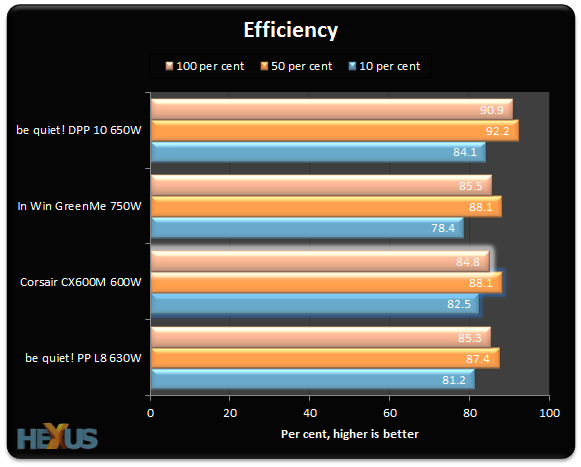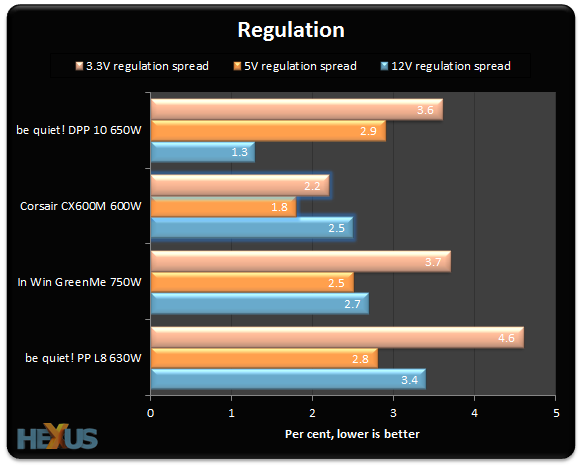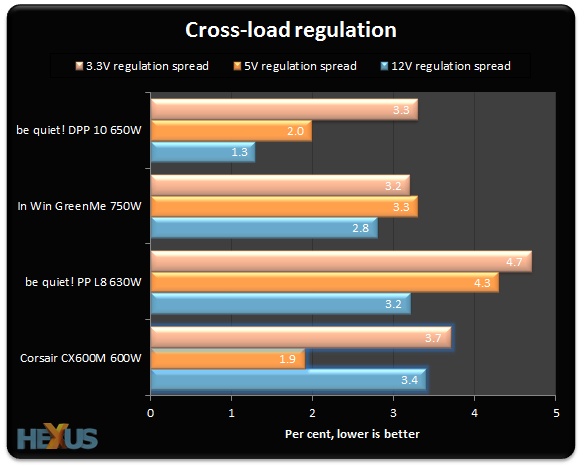How does it compare?
Our testing procedures can be found at this link.
Efficiency
| Load | 10pc | 25pc | 50pc | 75pc | 100pc |
|---|---|---|---|---|---|
| Efficiency | 82.5pc | 87.1pc | 88.1pc | 85.9pc | 84.8pc |
We like to see 80 per cent-plus efficiency at all loads, especially at the lower end of the scale, as the sub-100W figures are indicative of a modern PC in an idle state. The numbers are above average for a Bronze-rated model. Here's how it stacks up against a bevy of similar-wattage PSUs, ordered by efficiency at 50 per cent, though bear in mind the be quiet! DPP 10 is a Platinum-rated model costing twice as much.

Regulation
In terms of regulation, we're looking at just how well the supply is able to hold to the various lines. The ATX spec. has a +/- 5 per cent leeway on all but the -12V line.
| Line/Load | 3.3V | 5V | 12V |
|---|---|---|---|
| 10 per cent | +0.6pc | +1.8pc | +0.6pc |
| 50 per cent | -0.2pc | +0.6pc | -0.9pc |
| 100 per cent | -1.6pc | 0pc | -1.9pc |
Most supplies overvolt with little load and undervolt when stressed. We have no complaints here, especially at the budget £60 price, and you can see how it stacks up favourably against the competition. The graph is ordered by regulation on the important 12V line.

Regulation - cross-load
How about providing uneven loads that stress particular voltage rails? In the first attempt, we've put around 90 per cent of the load on the 12V rails, and just tickle the 3.3V and 5V rails- the exact amperage depends upon the capacity of the supply. This can actually be somewhat typical for a system heavy on graphics and CPU power. In the second, we've turned the tables and gone for 12A on both the 3.3V and 5V rails - highly unlikely in a real-world environment - and just 2A on the 12V - even more unlikely!
| Line/Load | 3.3V | 5V | 12V |
|---|---|---|---|
| Cross-load 12V focus | +1.4pc | +1.4pc | -2.2pc |
| Cross-load 3.3V/5V focus | -2.3pc | -0.5pc | +1.2pc |
Hammering one part of the PSU power delivery while using just a small portion of the other can throw cheaper supplies of out kilter. We'd be happy with the numbers on a more-expensive model.

Ripple
| Line/Load (mv - p-p max) | 3.3V | 5V | 12V |
|---|---|---|---|
| 10 per cent | 10mV | 10mV | 15mV |
| 50 per cent | 15mV | 15mV | 25mV |
| 100 per cent | 25mV | 20mV | 40mV |
The ATX v2.2 spec states that the maximum permissible ripple is 120mV for the 12V line and 50mV for others.
PSUs convert AC power into DC, but doing so requires the AC waveform to be suppressed. What we're really testing here is the quality of the supply's rectifier and any smoothing capacitors in getting rid of this unwanted up-and-down ripple. The figures are commendable for a cheap(er) supply and, again, better than average for the price.
Temps
| Temperatures | Intake | Exhaust |
|---|---|---|
| 10 per cent | 28°C | 32°C |
| 50 per cent | 34°C | 38°C |
| 100 per cent | 40°C | 46°C |
Solid temperatures at the 25°C ambient temperature.
Fan performance
Temps are good but they mean little in isolation. Obtaining accurate noise readings is near-on impossible when the supply is connected to the Chroma test harness and dual-unit load-tester. We can test the manufacturer's quietness claims in a different way, by using an AMPROBE TMA10A anemometer placed directly over the centre of the PSU. The anemometer records the airflow being pushed/pulled from the PSU's fan. We can use a Voltcraft DT-10L RPM meter to measure the rotational speed of the fan, too.

| Load | Fan RPM | Airflow | Noise |
|---|---|---|---|
| 10 per cent | 625rpm | circa-15cfm | Silent |
| 50 per cent | 1,250rpm | circa-35cfm | Very quiet |
| 100 per cent | 1,750rpm | circa-60cfm | Quiet |
The CX line doesn't have hybrid-fan technology found on the GS line, for instance, but to our ear, it remains silent to quiet at all times.









